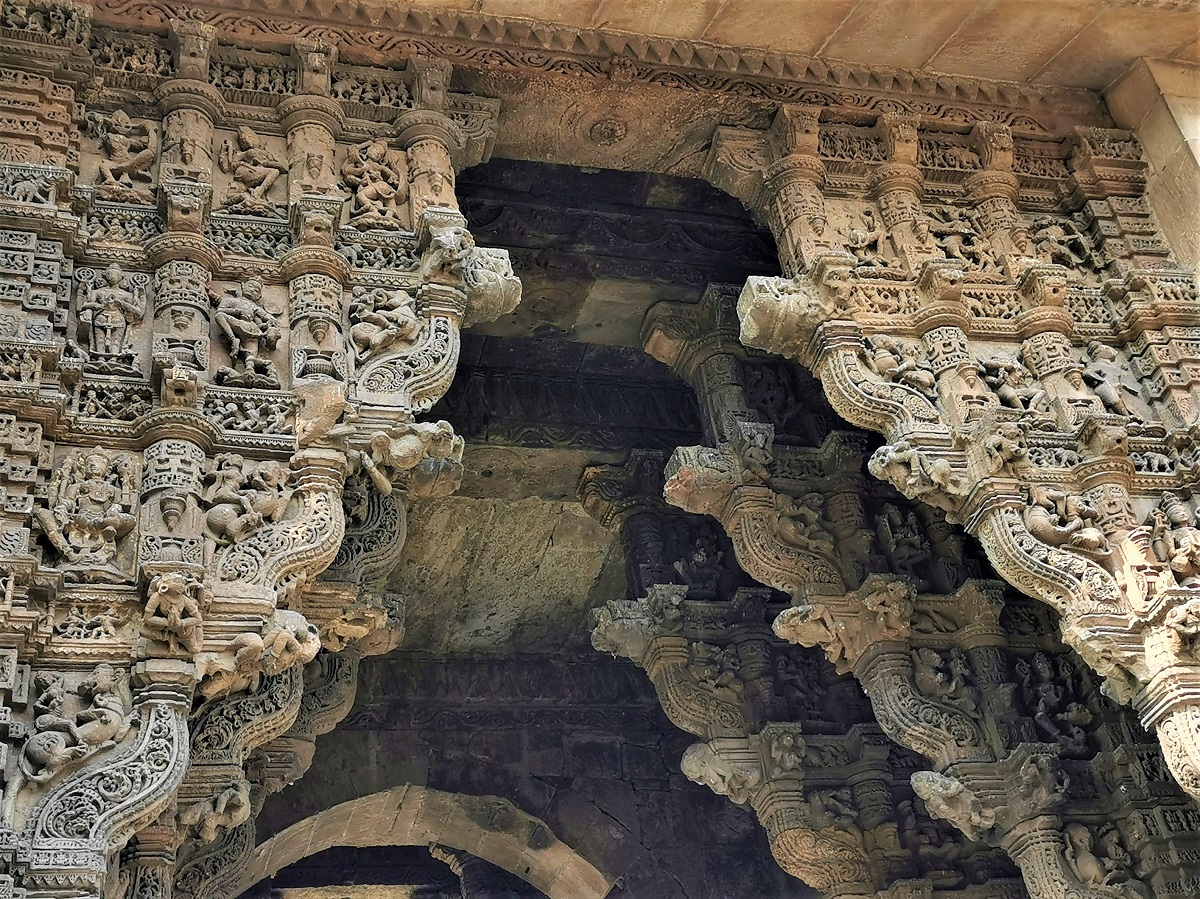THE RANNS, DESERTS, ARTISAN VILLAGES, STEPWELLS OF GUJARAT, AND NOW TO AHMEDABAD; EASTERN GUJARAT… IN 9 STORIES… THIS IS ‘STORY 8’
(Don’t forget to click on the photos to see them in their full size)
Eastern Gujarat – Part 1
The next day we began our travels to the South Eastern area of Gujarat. It was like starting a whole new trip where the terrain was quite different but the historical wonders continued to wow our travellers curiosity.
Dabhoi: An ancient town of great splendour
Arriving in Dabhoi, after a 3 hour journey along a modern highway lined with caster oil plantations, banana planatations, wonderful fields of cotton in full bloom waiting to be picked, and the sight of small farms lovingly tended by farming families for centuries, filled us with joy as we approached the city’s old gates. The original town was built in the 6th century but swelled to become a city with its high walls and varied gates constructed in the 15th century. The city was previously known as Darbhavati and the most ornate of the main gates was the ‘Hira Gate’ named after the famous architect Hira Bhagol. Here, there was a less ornate outer gate but when you came to the inner gate the carving takes one’s breath away.



These are the West gates, and the other gate we visited, more plain in its style, but strongly constructed and well preserved, was the Baroda gate. There is a 3rd and 4th gate respectively—the Champaner to the south and Chandod to the north—but we did not stop to see these as we drove through the extremely narrow main street of the old city. This was certainly not built for motorised traffic but was an interesting experience to drive through and see the even narrower side lanes and view the ancient carved merchants houses. What was fascinating about these house frontages was the carvings that were representative of the country with whom the merchant was doing business. There was Chinese art, Arabic (gulf nations), Iran, and many more.
In this old city, Jain, Hindu, and Muslims still live in harmony in a traditional way; but our guide told us that in the Muslim community, girls only go to school until Year 6/7 and then they help their mothers with the household duties. The boys are not really ‘encouraged’ but, if they show interest in learning, can continue at school. If the family has a business they work there with no higher education.
Discussions during the next drive
During our drive throughout the stunningly green forested countryside, our general discussion centred around the various cultural practices and the difficulty getting jobs after completing their education. We discussed the expectations of graduates who want to walk into high salaried positions but have no concept of starting at the bottom of the ladder and working hard for a long time to rise up through to the level of supervisor or a higher paid salary position.
Sankheda and the laquered furniture
A journey backwards from the end product to the raw wood:
We arrived in Sankheda on the Orsang River where we were given a walking tour of the town to visit the laquered furniture makers. We started with a shop where the furniture is displayed and sold, and worked backwards in the process until we saw the factory and the raw wood product before it started its process towards being an ostentatious piece of carved, brightly laquered and decorated furniture to grace someone’s home.


Some of the colours used in the laquer still come from vegetable dye but some are artificial and factory produced. From here we walked to visit a large factory room where the sealant is applied over the coloured laquer to give it a smooth finish. The room was not well ventilated and the smell of the sealant was overpowering, burning our eyes and catching in our throat, but the workers are sensitised to it and work with it all day.


Again, walking through narrow back lanes, we walked to the factory where the hand painting is done, an intricate art, then to the house where the wood pieces are carved on a laithe by craftsmen sitting on the steps of the house in which the carvers live.






Meeting our guides extended family
A surprise treat was then in store for us as we drove out of the city to an area by the river and had lunch with family members of our guide Hardik. We met his aunt and uncle, his very graceful and astute 80+ year old grandmother, and his cousins.


Raw wood & fine craftmanship
Two delightful wives cooked the most delicious food. Following lunch we visited the ‘factory’ where the raw wood is selected, cut, shaped, sanded, and made into many objects and pieces of furniture and doors.








Creativity and diversification in business
Being creative, this family business has diversified into house tiles, purchased in bulk and cut to size. The textures and colours were beautiful and were set to grace the homes of many.


A bucket list visit to the Narmada River
During our discussions as we left the farm factory, we discovered that we were only 35km from the Narmada River and this excited us greatly. Why? Narmada means—”One who endows with bliss”—and, according to Hindu mythology, the Narmada River is said to be one of the seven most sacred rivers in India, emerging out of the cosmic dance of Lord Shiva. Embodying purity as part of this legend, just sighting the river is said to be purifying. The river originates on the Amarkantak Plateau where the Vindhya and Saptura Mountain ranges meet and runs west 1247kms to the Arabian Sea. The banks of the river are lined with temples and bathing ghats; and the predominant agriculture alongside is sugarcane, cotton, and bananas. One of the very special aspects of spiritual reverence to this mighty river is the ‘Narmada Parkirama,’ or the circumbulation of the river. Beginning at Bharonch on the Arabian Sea and walking on foot, the sadhus (holy men) and pilgrims trek along the banks of the river to the source in the Maiakl Mountains and back to the ocean via the oppoiste bank. This meritorius walk takes between two and three years.



We drove to a town called Garudeshwar and walked down some ghats towards the river. However, we could not get right down to the water due to the damage done to these ghats by recent flooding. During this flooding the strong concrete steps and platforms were washed away with the power of the mighty river in flood. I had a feeling of the sacredness pervading the area. Our guide told us that after the flood, many crocodiles were found in the streets of the town, pushed up with the flood waters.

The ‘Statue of Unity’
Hardik then told us about a ‘massive’ statue recently erected about 5kms from Garudeshwar. Called ‘the statue of Unity’, it is for Sardar Vallabhai Patel (1875-1950). We decided to go visit this ‘friend of Gandhi’s’ memorial statue. Vallabhai Patel was Gandhi’s right hand man and the statue was erected as a ‘thank you’ for his work in bringing unity to all the 562 states of India after independence. He had proposed a dam be built on the Narmada River; however, it took 50 years to come to fruition and now this mighty project supplies electricity and water (via canals) to much of Gujarat, including Kutch. Around the statue, which sits on a large rock, a vast area was being prepared to become a lake where leisure water sports and boating can be enjoyed above one of the large dams created as part of this project.


The Palace of Jambughoda
Leaving the statue behind, we drove through more of the beautiful green forested countryside of teak and bamboo to stay a night in a ‘palace’ at Jambughoda. ‘A home for Nature Lovers’ is set in 100 acres of what is described as ‘sheer hypnotic beauty’ and is a two hour drive from Vadodara in the Vindhyas foothills. The rustic charm of the palace grounds, the dining room, and accommodation, allows one to rest and relax with no wifi or TV to disturb these tranquil surroundings.


You can wander the garden, and tree-lined paths to explore the estate at your leisure. The idea was conceived and developed by the King and Queen who were in residence in the main palace when we stayed there. The Maharana Vikramsinhji and Maharani Gyaneshwari of the Jambughoda Royal Family are descendants of the Parmar Dynasty. This wonderful retreat is situated close to the Jumbughoda Sanctuary where panthers, four horned antelope, blue bulls, wild boar, porcupines, wild hare, pythons, hyenas, snakes, and over 150 species of birds live in harmony with nature.







Story 9 (the LAST) … ‘Eastern Gujarat – part 2’… coming soon.
Travel organised with Suresh Bahuguna at Lotus India Journeys!
http://lotusindiajourneys.com/index.php
#travel #traveltheworld #worldtraveler #india #lettheadventurebegin #baroda #jambughodapalace #jambughoda #vadodara #gujarat #pavagadh #ahmedabad #photography #jambughodawildlifesanctuary #champaner #sankheda #dabhoi #jambughodaforest #narmada_river #narmada #gujarattourisim #loveournarmada #templesinindia #statueofunity #lacquerfurniture #homedecor #blacklacquer #interiordesign


















An unique and authentic travel journal exquisitely nourishing and fulfilling the quench of reader’s curiosity.
Immensely helpful to join the missing dots about our present generations to our glorious forgone past.
Thanks Team Teresa, for pushing yourself out the your comfort zone to help us to understand better the world around, thru the pure reflections of few sacred hearts. 💕
Thankyou Majeshji… it is wonderful to have your comments – the trip was exquisite, the memories long and lovely!! Teresa